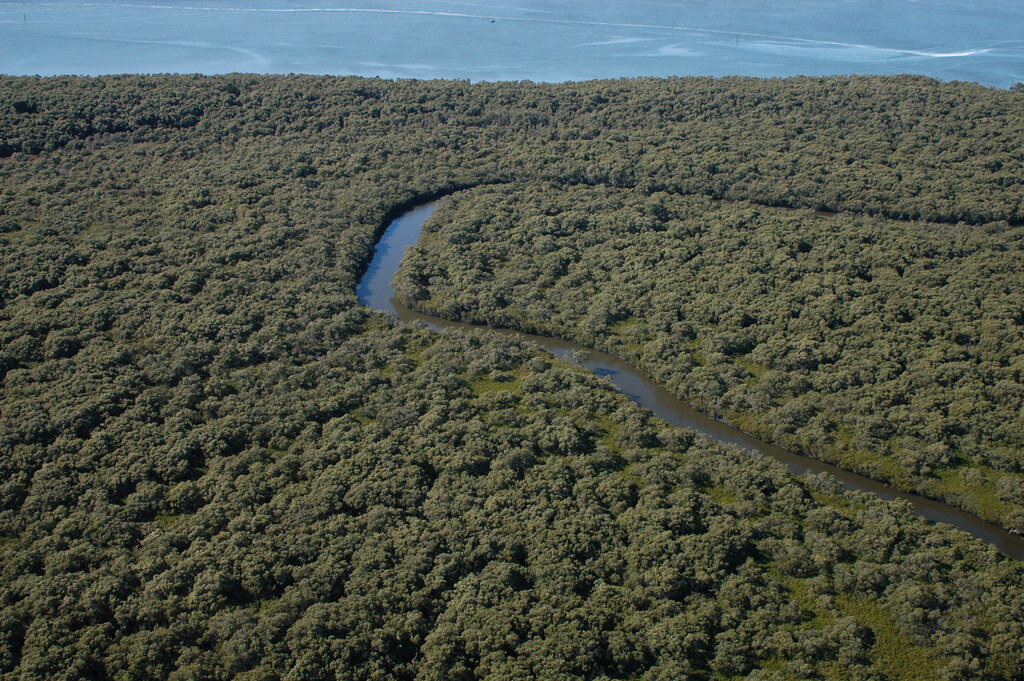Mangrove forests are an invaluable coastal ecosystem. Over the past several decades, they faced massive destruction, and now they are at risk from climate change.
An aerial view of a mangrove forest. Doug Beckers. CC BY-SA 2.0
Mangrove forests are one of the world’s most crucial ecosystems. They provide a habitat to a diverse range of creatures, help protect coastal areas from potentially harmful storm surges and are instrumental in carbon sequestration. For the past several decades, mangrove forests have been steadily destroyed by industrial development and aquaculture, as well as wood harvesting.
Naturally occurring in tropical and warm temperate areas, mangrove forests—sometimes called mangrove swamps—are groups of trees and shrubs that grow along coastlines. There are around 80 species of mangrove trees, all of which are some of the few coastal plants in the world that can prosper in salt water.
Mangrove forests are recognizable by their complex root systems which rise above the water, as though the trees are on stilts. Their raised roots allow mangrove trees to thrive despite the movement of the ocean, as the coastal areas where they grow are flooded at least twice a day with the coming of high tide. The protection provided by tangles of mangrove roots goes both ways, preventing storm surges from damaging inland areas and preventing pollutants from rivers and streams from entering the ocean environment. The above-ground section of the roots helps to slow tidal surges, allowing sediments to settle and build up on the ocean floor, reducing erosion. The entire root system filters out pollutants, like nitrates and phosphates, flowing from streams and rivers into the ocean.
The roots of a mangrove forest. Ravi Sarma. CC BY 2.0
A 2010 study found that mangroves were disappearing globally at a rate of one to two percent a year, and that between 1980 and 2005, 35 percent of all mangroves were lost. About half of the mangrove forests that do remain are reportedly in poor condition. In the past few decades, mangrove destruction was largely due to human activities. Most mangrove forests grow on public lands, very few of which receive any sort of protection. Coastal development such as the construction of hotels, power plants and marinas as well as aquaculture, agriculture, tourism and logging have been the main culprits behind global mangrove loss.
Today, satellite data suggests that human-caused mangrove loss has greatly declined. Thanks to conservation efforts from activists and governments across the globe, mangrove loss rates have decreased by 73 percent since 2000. This is good news, as the loss of mangroves has numerous negative effects on the environment, such as less protection for coastal areas and the loss of biodiversity. Mangroves are home to a variety of species of fish, especially juveniles, which use the mangroves’ root systems as a safe nursery habitat until they mature and migrate to coral reefs and other ecosystems. Mangroves are also the primary habitat for many seabirds and waterfowl, and even some terrestrial animals.
Yet, mangrove forests are still not safe. They face a new pressing threat, which is still rooted in human activities: climate change.
Scientists predict that, as a result of global warming, global sea levels will rise to unprecedented levels by as early as 2050. By the end of the century, sea levels will have risen at least a foot. Mangrove trees will be unable to withstand such rising sea levels; they are unlikely to be able to adapt to new sea levels within the time frame. As sea levels are rising, the chemistry of the ocean is changing as well, becoming more acidic than creatures in mangrove habitats are accustomed to. The creatures are also unlikely to adapt to a new environment quickly enough to survive, meaning that mass biodiversity loss could occur.
The harm to mangrove forests also has broader effects , as mangrove forests are one of the most important ecosystems in the fight against climate change. Mangrove trees are powerhouses of carbon sequestration, capturing carbon and other greenhouse emissions from the atmosphere and storing them in their root systems and soil for thousands of years. As global warming causes sea levels to rise and mangrove forests are lost, this stored carbon will be released back into the atmosphere, creating a positive feedback loop that further worsens the effects of climate change.
Experts agree that saving mangrove forests is key to combating climate change. In 2017, the World Wildlife Fund, Conservation International, The International Union for Conservation of Nature, The Nature Conservancy and Wetlands International partnered to form the Global Mangrove Alliance, which aims to fund monitoring and researching mangrove forests, as well as conservation and restoration initiatives.
To Get Involved:
For more about the Global Mangrove Alliance and how to support its mission, click here.
For information on how to preserve mangrove forests, visit conservation.org.
Rachel Lynch
Rachel is a student at Sarah Lawrence College in Bronxville, NY currently taking a semester off. She plans to study Writing and Child Development. Rachel loves to travel and is inspired by the places she’s been and everywhere she wants to go. She hopes to educate people on social justice issues and the history and culture of travel destinations through her writing.



